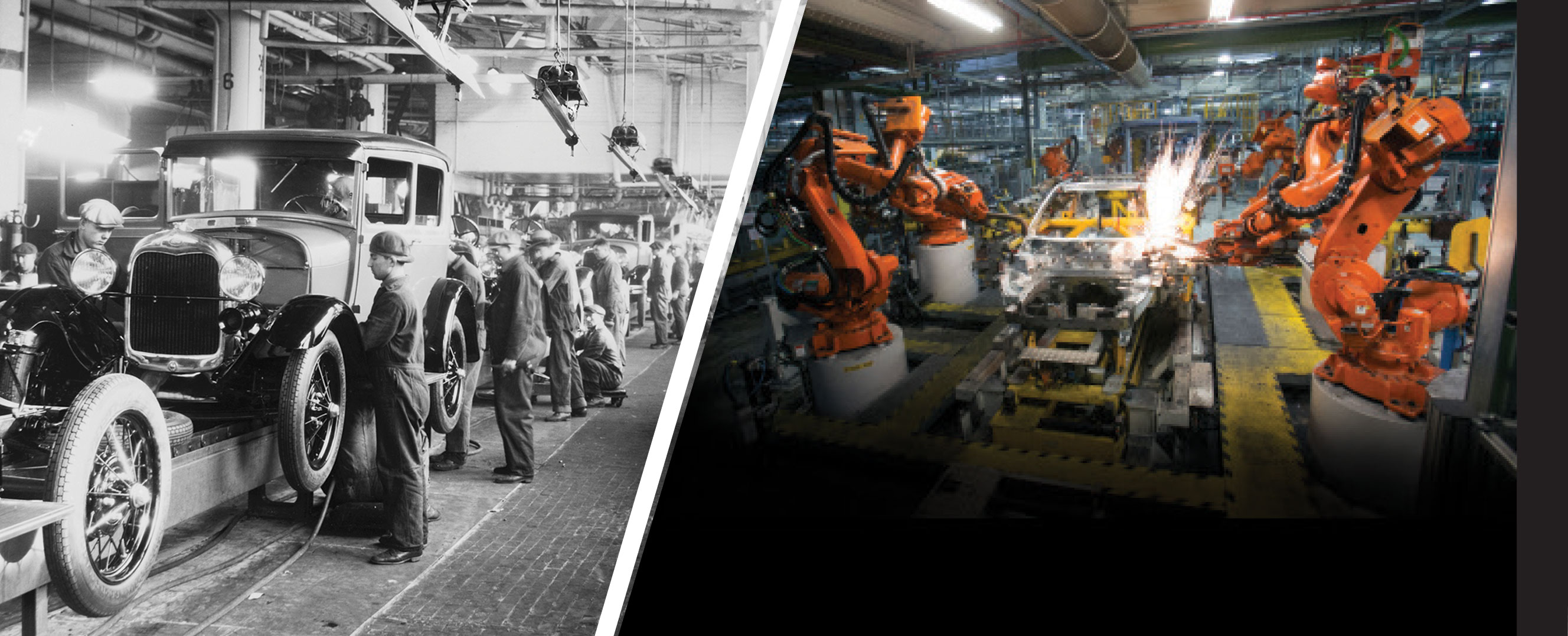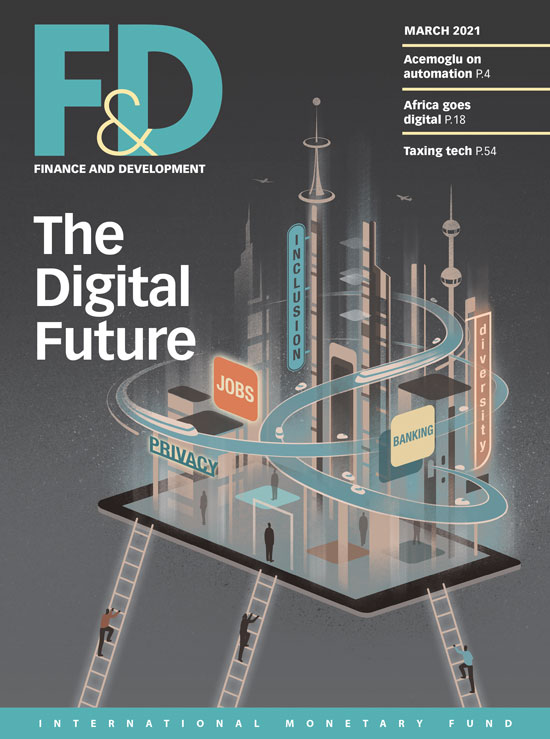To reverse widening inequality, keep a tight rein on automation
The industrialized world, especially the United States, suffered severe economic ills even before the COVID-19 pandemic. Unless we recognize them now, we are unlikely to produce solutions.
Chief among these problems is the nature of economic growth, which has become much less shared since the 1980s. Wider inequality in much of the industrialized world; the disappearance of good, high-paying, secure jobs; and the decline in the real wages of less-educated workers in the United States are all facets of this unshared growth (Acemoglu 2019), which has deepened discontent and sparked protests from both left and right in the years since the Great Recession.
My research with Pascual Restrepo indicates that automation accounts for much of this loss of shared growth, along with such factors as globalization and the declining power of labor relative to capital (Acemoglu and Restrepo 2019). With the next phase of automation rapidly unfolding, driven by machine learning and artificial intelligence (AI), the world’s economies stand at a crossroads. AI could further exacerbate inequality. Or, properly harnessed and directed through government policies, it could contribute to a resumption of shared growth.
Automation is the substitution of machines and algorithms for tasks previously performed by labor, and it’s nothing new. Ever since weaving and spinning machines powered Britain’s Industrial Revolution, automation has often been an engine of economic growth. In the past, however, it was part of a broad technology portfolio, and its potentially negative effects on labor were counterbalanced by other technologies boosting human productivity and employment opportunities. Not today.
The next phase of automation, relying on AI and AI-powered machines such as self-driving cars, may be even more disruptive, especially if it is not accompanied by other types of more human-friendly technologies. This broad technological platform, with diverse applications and great promise, could help human productivity and usher in new human tasks and competencies in education, health care, engineering, manufacturing, and elsewhere. But it could also worsen job losses and economic disruption if applied exclusively for automation.
The pandemic has certainly given employers more reasons to look for ways of substituting machines for workers, and recent evidence suggests they are doing so (Chernoff and Warman 2020).
Some argue that pervasive automation is the price we pay for prosperity: new technologies will increase productivity and enrich us, even if they dislocate some workers and disrupt existing businesses and industries. The evidence does not support this interpretation.
Despite the bewildering array of new machines and algorithms all around us, the US economy today generates very low total factor productivity growth—economists’ headline measure of the productivity performance of an economy, which gauges how efficiently human and physical capital resources are being used. In particular, total factor productivity growth has been much lower over the past 20 years than during the decades after World War II (Gordon 2017). Even though information and communication technology has advanced rapidly and is applied in every sector of the economy, industries that rely more intensively on these technologies have not performed better in terms of total factor productivity, output, or employment growth (Acemoglu and others 2014).
The reasons for this recent slow productivity growth are not well understood. But one contributing factor appears to be that many automation technologies, such as self-checkout kiosks or automated customer service, are not generating much total factor productivity growth. Put differently, rather than bringing productivity dividends, automation has been excessive because businesses are adopting automation technologies beyond what would reduce production costs or because these technologies have social costs because they give rise to lower employment and worker wages. Excessive automation may also be a cause of the slowdown in productivity growth. This is because automation decisions are not reducing costs and, even more important, because a singular focus on automation technologies may be causing businesses to miss out on productivity gains from new tasks, new organizational forms, and technological breakthroughs that are more complementary to humans.
But is automation really excessive? I believe so. First of all, when employers make decisions about whether to replace workers with machines, they do not take into account the social disruption caused by the loss of jobs—especially good ones. This creates a bias toward excessive automation.
Even more important, several factors appear to have fueled automation beyond socially desirable levels. Particularly important has been the transformation in the corporate strategies of leading US companies. American and world technology is shaped by the decisions of a handful of very large, very successful tech companies that have tiny workforces and a business model built on automation (Acemoglu and Restrepo 2020). Big Tech companies including Amazon, Alibaba, Alphabet, Facebook, and Netflix are responsible for more than $2 of every $3 spent globally on AI (McKinsey Global Institute 2017). Their vision, centered on the substitution of algorithms for humans, influences not only their own spending but also what other companies prioritize and the aspirations and focus of hundreds of thousands of young students and researchers specializing in computer and data sciences.
Of course there is nothing wrong with successful companies pursuing their own vision, but when this becomes the only game in town, we must be on guard. Past technological successes have more often than not been driven by a diversity of perspectives and approaches. If we lose this diversity, we also risk losing our technological edge.
The dominance of a handful of companies over the path of future technology has been exacerbated as well by dwindling support from the US government for fundamental research (Gruber and Johnson 2019). In fact, government policy excessively encourages automation, especially through the tax code. The US tax system has always treated capital more favorably than labor, encouraging businesses to substitute machines for workers, even when workers may be more productive.
My research with Andrea Manera and Pascual Restrepo shows that, over the past 40 years, labor has paid an effective tax rate of more than 25 percent via payroll and federal income taxes (Acemoglu, Manera, and Restrepo 2020). Even 20 years ago, capital was more lightly taxed than labor, with equipment and software investment facing tax rates of about 15 percent. This differential has widened with tax cuts on high incomes, the conversion of many businesses to closely held S corporations that are exempt from corporate income taxes, and generous depreciation allowances. As a result of these changes, investments in software and equipment are taxed at rates of less than 5 percent today, and in some cases corporations can even derive net subsidies when they invest in capital. This creates a powerful motive for excessive automation.
A path of future technology centered on automation is not preordained. It is a consequence of choices by researchers who focus on automation applications at the expense of other uses of technology and by companies that build business models on automation and reducing labor costs rather than on broad-based productivity increases. We can make different choices. But such a course correction calls for a concerted effort to redirect technological change, which can happen only if government plays a central role in the regulation of technology.
Let me be clear that I do not mean government blocking technology or slowing technological progress. Rather, the government should provide incentives that tilt the composition of innovation away from an excessive focus on automation and more toward human-friendly technologies that produce employment opportunities, especially good jobs, and a more shared form of economic prosperity. We do not know exactly what the most transformative human-friendly technologies of the future may be, but many sectors provide plenty of opportunities. These include education, where AI can be used for much more adaptive and student-centered teaching combining new technologies and better-trained teachers; health care, where AI and digital technologies can empower nurses and technicians to provide more and better services; and modern manufacturing, where augmented reality and computer vision can increase human productivity in the production process. We have also witnessed during the pandemic how new digital technologies, such as Zoom, have fundamentally broadened human communication and capabilities.
This recommendation may still strike many as unusual. Isn’t it highly distortionary for governments to influence the direction of technology? Could they really influence where technology goes? Wouldn’t we be opening the door to a new kind of totalitarianism with the state intervening even in technological decisions?
I maintain that in fact there is nothing unusual or revolutionary about this idea. Governments have always influenced the direction of technology, and we already know how to build institutions that do this in a more beneficial way for society.
Governments around the world routinely affect the direction of technology via tax policies and support for corporate research and universities. As I have shown, the US government has encouraged automation through its asymmetric taxation of capital and labor. A first step would be to correct that imbalance. This would go a long way but would not be sufficient by itself. Much more can be done—for example, via R&D subsidies targeted to specific technologies that help human productivity and increase labor demand.
This brings me to the second objection: can the government really effectively redirect technology? My answer is that governments have done this in the past, and in many cases with surprising effectiveness. The transformative technologies of the 20th century, such as antibiotics, sensors, modern engines, and the internet, would not have been possible without the government’s support and leadership. Nor would they have flourished as much without generous government purchases. Even more relevant, perhaps, for efforts to redirect technology in a human-friendly trajectory is the example of renewable energy.
Four decades ago renewable energy was prohibitively expensive, and the basic know-how for green technologies was lacking. Today renewables make up 19 percent of energy consumption in Europe and 11 percent in the United States, and costs have declined in the same ballpark as fossil-fuel energy (IRENA 2020). This has been achieved thanks to a redirection of technological change away from a singular focus on fossil fuels toward greater efforts for advances in renewables. In the United States, the primary driver of this redirection has been modest government subsidies for green technologies as well as the changing norms of consumers.
The same approach can strike a balance between automation and human-friendly technologies. As in the case of renewable energy, change must start with a broader societal recognition that our technology choices have become highly unbalanced, with myriad adverse social consequences. There needs to be a clear commitment by the federal government to redress some of these imbalances. The government should also address the dominance of a handful of big tech companies over their markets and the direction of future technology. This of course would have other benefits, such as ensuring greater competition and protecting privacy.
The most challenging objection to these ideas is political—the same challenge raised by Friedrich Hayek to the development of Britain’s welfare state in what became his celebrated book The Road to Serfdom. Hayek warned against the rise of the administrative state, arguing that it would crush society and its freedoms. As he later summarized it, his concern was that
-
… extensive government control produces … a psychological change, an
alteration in the character of the people.… Even a strong tradition of
political liberty is no safeguard if the danger is precisely that new
institutions and policies will gradually undermine and destroy that spirit.
Although Hayek’s concerns were well-placed, he turned out to be wrong. Liberty and democracy were not quashed in the United Kingdom or in Scandinavian countries that adopted similar welfare state programs. On the contrary, by ensuring a social safety net, these systems sparked greater opportunities for individual freedom to flourish.
There is an even more fundamental reason the welfare state did not threaten liberty and democracy. James Robinson and I lay out the conceptual framework in our new book, The Narrow Corridor (Acemoglu and Robinson 2019). We explain why the best guarantors of democracy and liberty are not constitutions or clever designs of separation of powers, but society’s mobilization. That requires a balance between state and society that puts the polity in the narrow corridor where liberty flourishes and where the state and society can gain strength and capacity together. So when we need the state to shoulder greater responsibilities, we can also experience a deepening of democracy and greater societal mobilization. This means citizens actively participating in elections and becoming informed about politicians and their agendas (and their misdeeds), civil society organizations expanding, and media helping to hold politicians and bureaucrats accountable. This is what happened in much of the industrialized world. As the state took on more, democracy deepened and society’s involvement and ability to keep politicians and bureaucrats in check intensified.
Whether society can play its part in forging a new chapter in our history is an open question. A major complicating factor is that new digital technologies have also weakened democracy. With misinformation rising, AI-powered social media creating filter bubbles and echo chambers inimical to democratic discourse, and political engagement waning, we may not have the right tools to keep the state in check. Yet we do not have the luxury not to try.
References:
Acemoglu, Daron. 2019. “It’s Good Jobs, Stupid.” Economics for Inclusive Prosperity Policy Brief 13.
Acemoglu, Daron, David Autor, David Dorn, Gordon H. Hanson, and Brendan Price. 2014. “Return of the Solow Paradox? IT, Productivity, and Employment in US Manufacturing.” American Economic Review 14 (5): 394–99.
Acemoglu, Daron, Andrea Manera, and Pascual Restrepo. 2020. “Does the US Tax Code Favor Automation?” Brookings Papers on Economic Activity (Spring).
Acemoglu, Daron, and Pascual Restrepo. 2019. “Automation and New Tasks: How Technology Changes Labor Demand.” Journal of Economic Perspectives 33 (2): 3–30.
———. 2020. “The Wrong Kind of AI? Artificial Intelligence and the Future of Labour Demand.” Cambridge Journal of Regions, Economy and Society 13 (1): 25–35.
Acemoglu, Daron, and James A. Robinson. 2019. The Narrow Corridor: States, Societies, and the Fate of Liberty. New York: Penguin.
Chernoff, Alex, and Casey Warman. 2020. “COVID-19 and Implications for Automation.” NBER Working Paper 27249, National Bureau of Economic Research, Cambridge, MA.
Gordon, Robert J. 2017. The Rise and Fall of American Growth: The US Standard of Living since the Civil War. Princeton, NJ: Princeton University Press.
Gruber, Jonathan, and Simon Johnson. 2019. Jump-Starting America: How Breakthrough Science Can Revive Economic Growth and the American Dream. New York: Public Affairs.
International Renewable Energy Agency (IRENA). 2019. “Renewable Power Generation Costs in 2018.” Abu Dhabi.
International Renewable Energy Agency (IRENA). 2020. “Renewable Power Generation Costs in 2019.” Abu Dhabi.
Lazard. 2019. “Levelized Cost of Energy and Levelized Cost of Storage.” New York.
McKinsey Global Institute. 2017. “Artificial Intelligence: The Next Digital Frontier?” Discussion Paper. New York.
Ritchie, Hannah, and Max Roser. 2017. “Renewable Energy.” Our World in Data.
Opinions expressed in articles and other materials are those of the authors; they do not necessarily represent the views of the IMF and its Executive Board, or IMF policy.









